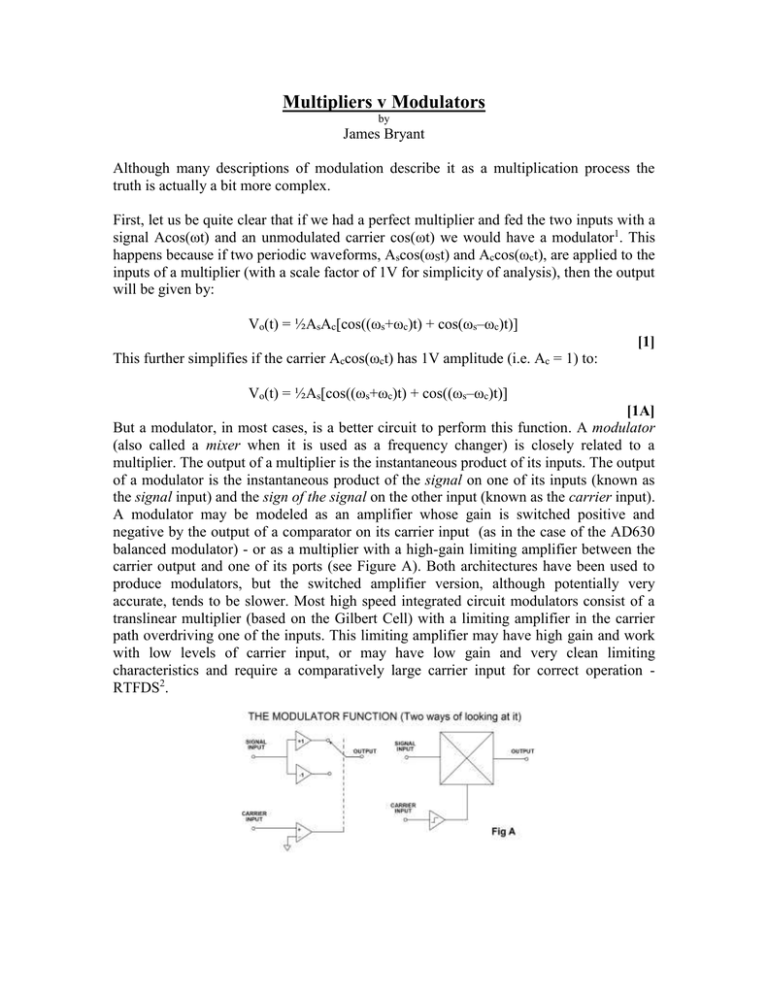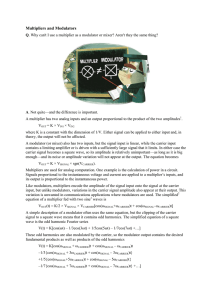Multipliers v Modulators
advertisement

Multipliers v Modulators
by
James Bryant
Although many descriptions of modulation describe it as a multiplication process the
truth is actually a bit more complex.
First, let us be quite clear that if we had a perfect multiplier and fed the two inputs with a
signal Acos(ωt) and an unmodulated carrier cos(ωt) we would have a modulator1. This
happens because if two periodic waveforms, Ascos(ωSt) and Accos(ωct), are applied to the
inputs of a multiplier (with a scale factor of 1V for simplicity of analysis), then the output
will be given by:
Vo(t) = ½AsAc[cos((ωs+ωc)t) + cos(ωs–ωc)t)]
[1]
This further simplifies if the carrier Accos(ωct) has 1V amplitude (i.e. Ac = 1) to:
Vo(t) = ½As[cos((ωs+ωc)t) + cos((ωs–ωc)t)]
[1A]
But a modulator, in most cases, is a better circuit to perform this function. A modulator
(also called a mixer when it is used as a frequency changer) is closely related to a
multiplier. The output of a multiplier is the instantaneous product of its inputs. The output
of a modulator is the instantaneous product of the signal on one of its inputs (known as
the signal input) and the sign of the signal on the other input (known as the carrier input).
A modulator may be modeled as an amplifier whose gain is switched positive and
negative by the output of a comparator on its carrier input (as in the case of the AD630
balanced modulator) - or as a multiplier with a high-gain limiting amplifier between the
carrier output and one of its ports (see Figure A). Both architectures have been used to
produce modulators, but the switched amplifier version, although potentially very
accurate, tends to be slower. Most high speed integrated circuit modulators consist of a
translinear multiplier (based on the Gilbert Cell) with a limiting amplifier in the carrier
path overdriving one of the inputs. This limiting amplifier may have high gain and work
with low levels of carrier input, or may have low gain and very clean limiting
characteristics and require a comparatively large carrier input for correct operation RTFDS2.
We use modulators rather than multipliers for several reasons. Both ports of a multiplier
are linear, so any noise or modulation on the carrier input multiplies the signal input and
degrades it, while amplitude variation on the carrier input of a modulator can mostly be
ignored3. We disregarded this effect in our earlier brief analysis, but it cannot be ignored
in real life. Also it is easier to design and manufacture a high performance high frequency
modulator than a similar multiplier. In a short note like this it is inappropriate to perform
detailed analyses but one simple model of a modulator has switches driven by the carrier,
and a (perfect) open switch has infinite resistance and zero thermal noise current and a
(perfect) closed switch has zero resistance and zero thermal noise voltage - so
modulators, even though their switches are less than perfect, tend to have less internal
noise than multipliers.
Like an analog multiplier, a modulator multiplies two signals. But unlike analog
multipliers, the multiplication is not linear. Instead, the signal input is multiplied by +1
when the polarity of the carrier input is positive and by -1 when it is negative. In other
words it is multiplied by a square wave at the carrier frequency.
A square wave with a frequency of ct may be represented by the Fourier series of odd
harmonics:
K[cos(ωct)–1/3cos(3ωct)+1/5cos(5ωct)–1/7cos(7ωct)+.Etc..]
[2]
The sum of the series: [1, –1/3, +1/5, –1/7 +...] is π/4. Therefore, the value of K is 4/π,
such that a balanced modulator acts as a unity gain amplifier when a positive DC signal is
applied to its carrier input.
So if a modulator is driven by a signal Ascos(ωst) and a carrier cos(ωct) (the carrier
amplitude is unimportant provided only that it is great enough to drive the limiting
amplifier), then the output will be the product of the signal and the squared carrier:
2As/π[cos(ωs+ωc)t + cos(ωs–ωc)t
–1/3{cos(ωs+3ωc)t + cos(ωs–3ωc)t}
+1/5{cos(ωs+5ωc)t + cos(ωs–5ωc)t}
–1/7{cos(ωs+7ωc)t + cos(ωs–7ωc)t} + .Etc..]
[3]
This output contains sum and difference frequencies of the signal and carrier, and of the
signal and each of the odd harmonics of the carrier (in the ideal, perfectly balanced,
modulator, products of even harmonics are not present - in real modulators, which have
residual offsets on their carrier ports, low-level even harmonic products are also present,
just how low their level depends on the size of the offset). In many applications, an LPF
(Low Pass Filter) removes the products of the higher harmonics. (In analyzing the above
expressions, we must remember that cos(A) = cos(–A), so that
cos(ωm–Nωc)t =
cos(Nωc–ωm)t, so we do not have to worry about "negative frequencies".) After filtering,
the modulator output is given by:
2As/π[cos(ωs+ωc)t + cos(ωs–ωc)t]
[4]
This is the same expression as the output of a multiplier, except that the gain is slightly
different. (We shall not consider the theoretical gains of various systems here, since in
practical systems they are normalised by amplifiers or attenuators.)
So in simple cases it is obviously better to use a modulator than a multiplier. But how do
we define simple? When a modulator is used as a frequency changer the signal and
carrier inputs are simple sine waves at frequencies f1 and fc and the output before the LPF
just contains the sum (f1+fc) and difference1 (f1-fc) frequencies and the sum and
difference frequencies of the signal and the odd harmonics of the carrier (f1+3fc), (f1+5fc),
(f1+7fc), etc., and (f1-3fc), (f1-5fc), (f1-7fc), etc. After the LPF we expect to find just the
fundamental products, (f1+fc) and (f1-fc).
But if1 (f1+fc)>(f1-3fc) it will not be possible to separate the fundamental and harmonic
products with a simple LPF since one of the harmonic products is at a lower frequency
than one of the fundamental products. This is not a simple case, so more analysis is
needed.
If we assume that the signal contains a single frequency f1, or a more complex signal
spread across the band from f1 to f2 we can analyse the output spectrum of our modulator
as follows. In all the following diagrams inputs are shown in black (the signal input is
shown in pale grey in diagrams of outputs, even though it is not actually present) and we
shall assume a perfectly balanced modulator without signal leak, carrier leak or
distortion, so that the input, the carrier, and spurious products do not appear in the output.
Figure B shows the inputs - a signal in the band f1 to f2 and a carrier at fc. If the device is
a multiplier rather than a modulator the harmonic inputs at 1/3(3fc), 1/5(5fc), 1/7(7fc), etc.
are not present. These odd carrier harmonics are shown as dotted lines - note that the
fractions 1/3, 1/5, 1/7, etc. refer to their amplitudes, not their frequencies.
Figure C shows the output of a multiplier, or of a modulator with an LPF with a cutoff
frequency of 2fc.
Figure D shows the output of an unfiltered modulator (but not harmonic products above
7fc).
These diagrams show that if the signal band f1 to f2 lies within the Nyquist band, as the
band of frequencies from DC to fc/2 is known, an LPF with cutoff above 2fc will cause a
modulator to have the same outputs as a multiplier.
At signal frequencies above this things become more complex.
Figure E shows what happens when the signal band is just below fc. It is still possible to
separate the harmonic products from the ones produced by the fundamental, but now it
requires a very abrupt LPF.
As the signal band passes through Fc we see from Fig F that the fundamental difference
spectrum is no longer inverted, and the harmonic products no longer group together but
overlap (i.e. (3fc-f1)<(fc+f1)) and the fundamental products can no longer be separated
from the harmonic products by an LPF but the required signals must be selected by a
bandpass filter (BPF).
It is therefore evident that although modulators are better than linear multipliers for most
frequency changing applications it is important to consider their harmonic products when
designing real systems.
James Bryant
Calshot - England
March 2013
1
Note that using the cosine formulae rather than sine formulae makes the equations easier to
manipulate because cos(a)=cos(–a) (which makes sign unimportant during simplification and
where a calculation yields a "negative frequency" the expression is exactly equal to the
corresponding "positive frequency"), and because cos(0)=1, so that for DC signals when aωt=0
cos(aωt)=1. Note also that throughout this article the sign of negative frequencies is assumed
positive, so the expression (f1-f2) is treated as positive, even when f2>f1.
2
3
Read The Friendly Data Sheet.
There are second-order mechanisms whereby amplitude noise on a modulator's carrier input
may affect the output but these are minimised in the best modulators and will not be discussed in
any more detail here.






